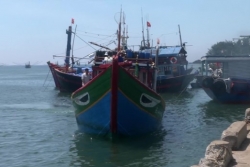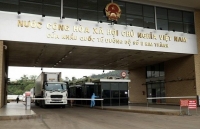
Ugly Face of China’s Conduct in the South China Sea
Latest
| TIN LIÊN QUAN | |
| Indian scholar lauds Vietnam's efforts in containing COVID-19 pandemic | |
| Workshop looks at Vietnam-India cooperation potential | |
In recent times, Chinese behaviour has seen a more assertive posture. It has racked up trouble with India over border incursions, the US over trade issues, many countries in Southeast Asia on territorial issues, particularly making a controlling stake illegally on the exclusive economic zones of Vietnam, the Philippines and Malaysia of the South China Sea. These are clear demonstrations of a new hegemon in ascendency in the Asian firmament, spreading unease in the region and the world.
It is claiming the South China Sea almost in its entirety as its own disregarding other countries’ legitimate claims based on historical evidence. It lost its case taken to the international court of arbitration by the Philippines in July 2016 over its claim in the South China Sea. The court ruled that China’s claims have no legal basis and thus invalid. China rejected the ruling outright knowing well that the court lacked enforcing authority of its verdict.
The ulterior Chinese motive demonstrated by its muscle-flexing activities to intimidate the smaller nations in its neighbourhood is sign of its grand design to emerge as the sole superpower eclipsing the US by pursuing means even though those violates or disrespects global rules and norms.
These unpleasant experiences did not deter China to deflect the attention of the world by sinking a Vietnamese vessel in the South China Sea on April 2. The South China Sea has been a potential flashpoint as half a dozen countries make contending claims to some parts of this oceanic space. In contrast, China claims the entire area as its own, which is why it continues to create problems whenever other contending nations make their presence in the area they claim as their own.
| Read more |
 Fisheries Society opposes China’s inhumane act in East Sea Fisheries Society opposes China’s inhumane act in East Sea |
While the world is distracted by the coronavirus pandemic, Beijing has increased pressure on its nervous neighbours in its quest to dominate the entire South China Sea. China has been quietly taking paramilitary and political-legal actions in the South China Sea that could be game-changing for the region. It finds the time opportune as the US, its main adversary and perceived competitor for global dominance, is focused elsewhere and exhausted from years of Chinese encroachments, its efforts are approaching an irretrievable tipping point. China aims to coerce its maritime neighbours to abandon their claims and territorial rights under international law and irrevocably alter the status quo. Beijing seeks to impose its so-called nine-dash line, an unrecognized boundary it has drawn around 85 percent of the South China Sea, almost all of it in international waters, and through which $3.4 trillion in shipped goods pass each year—freely, at least for now.
Amid the recent muscle-flexing in the disputed South China Sea, one maritime drill went largely unnoticed. If not dealt deftly, it could be an important harbinger of China's strategic thinking, and how its forces could project power across heavily contested waters. It involved the People's Liberation Army Navy Marine Corps (PLANMC) - an arm of the Chinese military that is growing fast as the PLA develops expeditionary forces that can operate further from China's shores.
The current strength of the Marine Corps is nearly 35,000, which tripled over the past three years. This figure is based on a report prepared by Jane’s for the US-China Economic and Security Review Commission. The Corps has become a more visible presence in the South China Sea. On May 5, the PLANMC undertook an anti-piracy exercise near the Paracel Islands that showed off its capabilities to China's neighbours at a time of rising tensions in the region. The exercise simulated covert, amphibious assaults by the PLANMC with fast-moving speedboats and naval aviation aircraft, integrating the corps' operations with the People's Liberation Army Navy.
The Corps has planned another military exercise in the South China Sea in August. Among other things, it has planned simulating an island seizure operation. It is part of a two-and-a-half-month-long series of drills involving the army, navy, and the PLANMC that has already begun. Though China's state media has not confirmed such an island-seizing exercise would take place, that are enough hints that such an exercise would be warranted and designed to simulate a takeover of Taiwan and its outlying islands in the event of a "secession." Taiwan is a self-governing democracy that Beijing regards as part of China. So far, Taiwan has stood its ground despite continuous threat of use of force to integrate with the mainland, should the current President Tsai Ing-wen declare independence. That situation could be messy.
Like Brunei, Malaysia, the Philippines and Vietnam, Taiwan is also claimant in the South China Sea. It is closely monitoring the movement of China’s military. Other claimants are too keeping an eye on such manoeuvres by Chinese amphibious forces with some concern. The concern is real because the PLANMC is meant to be the “nucleus” for China’s armed forces as they operate further afield. The PLA is intent on improving its expeditionary capabilities and the Marines are considered a key, if not the core, component of this expeditionary force. The South China Sea is an obvious and convenient training ground for Chinese marines. It is unclear at the moment if China has any plan for a permanent PLANMC presence there.
Because of its amphibious capabilities, the PLANMC gets high priority by the Chinese military planners as the marines are supposed to be a rapid response force. They have been primarily focused on non-combat operations in recent years, especially anti-piracy missions. According to the inter-governmental information-sharing group based on the Regional Cooperation Agreement on Combating Piracy and Armed Robbery against Ships in Asia, or ReCAAP, as reported in its latest quarterly report, there has been a sharp increase in armed robberies at sea in Southeast Asia. Though most of the lawlessness was in the Straits of Malacca or in the Sulu Sea, and there were very few incidents in the South China Sea during 2019, the Chinese do not want to take any chance and like to secure the area from piracy activities.
| Tin liên quan |
 Maintaining peace in South China Sea requires international efforts: Vietnamese Deputy Foreign Minister Maintaining peace in South China Sea requires international efforts: Vietnamese Deputy Foreign Minister |
That was the reason why the PLANMC’s anti-piracy drill took place in islands in the northern half of South China Sea, an area disputed by Vietnam, the Philippines and Taiwan. The Paracels were placed under 'Xisha District' in a controversial move by China in April to assert administrative control over the disputed features – along with the Pratas Islands currently occupied by Taiwan.
China does contribute financially to regional information sharing centers focused on piracy in the region. Most of China's anti-piracy efforts at sea were concentrated in the Gulf of Aden off the coast of east Africa and there are no recorded joint patrols aimed at anti-piracy between China and Southeast Asian states, aside from joint patrols China has undertaken up the Mekong River. This fuels scepticism about whether the PLANMC May 5 drill was motivated by Beijing's concern about piracy in the South China Sea, or to send a message to the other claimants.
From China’s recent activities, it transpires that under cover of pandemic, China has stepped up brinkmanship in South China Sea. Beijing is creating facts on the ground. Its claims to the disputed islets and reefs encompassing the Paracel and Spratly islands, which it calls Xisha and Nansha respectively, have a questionable basis in international law and are based instead on an oval-shaped series of dashes drawn on map of the South China Sea. These islets, some of which Beijing has artificially reclaimed and fortified with military bases, overlap with claims by Malaysia, the Philippines, Vietnam, and Brunei.
China’s line was originally drawn by the pre-Communist government of Chiang Kai-shek in 1947 and modified in 1952 by Mao Zedong. In 2009, in a diplomatic note to the Commission on the Limits of the Continental Shelf, China attached the dashed-line map and claimed that it had “indisputable sovereignty over the islands in the South China Sea and the adjacent waters, and enjoys sovereign rights and jurisdiction over the relevant waters as well as the seabed and subsoil thereof.” Beijing has pressed that claim with growing assertiveness ever since, all the while exploiting the ambiguity of terms such as “adjacent” and “relevant.”
Beijing says its claims are fundamentally incompatible with established international law on maritime boundaries, the United Nations Convention on the Law of the Sea (UNCLOS), which it has ratified and by which it professes to abide. However, its claims were ruled fraudulent by an international tribunal in The Hague. This is part of a broader Chinese strategy to create its own version of the Monroe Doctrine, the 19th-century policy by which the US claimed all of North and South America as its rightful area of control at the exclusion of the European powers. Beijing seeks a sphere of decisive influence with military defense capabilities to raise the cost of any potential US intervention. In short, while the world fights Covid-19, China is moving closer to establishing regional dominion.
At the 36th ASEAN virtual Summit themed “Cohesive and Responsive ASEAN” that took place in Hanoi on June 26, 2020 under the chair of Prime Minister Nguyen Xuan Phuc, though the pressing issue of seeking strategy to combat Covid-19 pandemic in the region and the world was addressed, the issue of Chinese incursion in the South China Sea was also debated. In particular, Vietnam and the Philippines raised concern over growing insecurity in the region amid China’s increased activities in the disputed South China Sea. Philippine President Rodrigo Duterte called upon “parties to refrain from escalating tensions and abide by responsibilities under international law”. Even the United States has called upon China to stop its “bullying behaviour” there. It is regrettable that during the current global crisis, international institutions and international law had been seriously challenged by China. It is hoped that China mends its ways and conducts its policies in accordance with existing global norms and rules of law, and does not infringe upon another country’s territorial jurisdiction and sovereignty.
-------
(The views expressed are personal)

| Vietnam requests China to investigate incident related to Vietnamese fishing vessel in Hoang Sa Vietnam has affirmed its sovereignty over the Hoang Sa (Paracel) archipelago and requested China to investigate the incident involving the acts of Chinese vessels against ... |

| Vietnam, China discuss ways to foster bilateral cooperation amid COVID-19 pandemic Deputy Foreign Minister Le Hoai Trung, Vietnam’s general secretary of the Steering Committee for Vietnam–China Bilateral Cooperation, held an online conference with the committee’s Chinese ... |

| Vietnam, China works to fuel agricultural trade after COVID-19 pandemic Vietnam and China are going to hold several teleconferences in the next few days to promote the trade of agricultural products and specialties after COVID-19 ... |

















